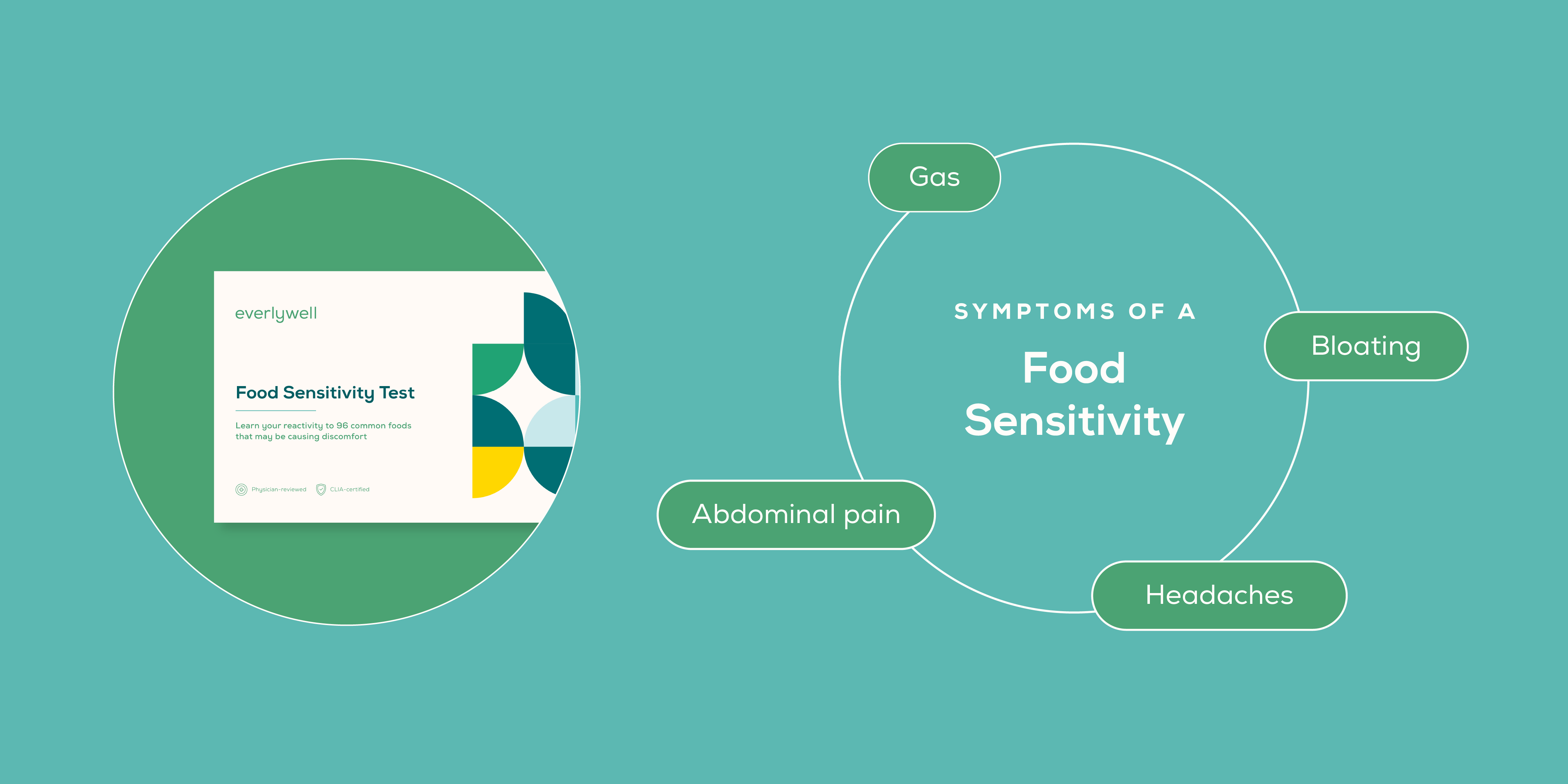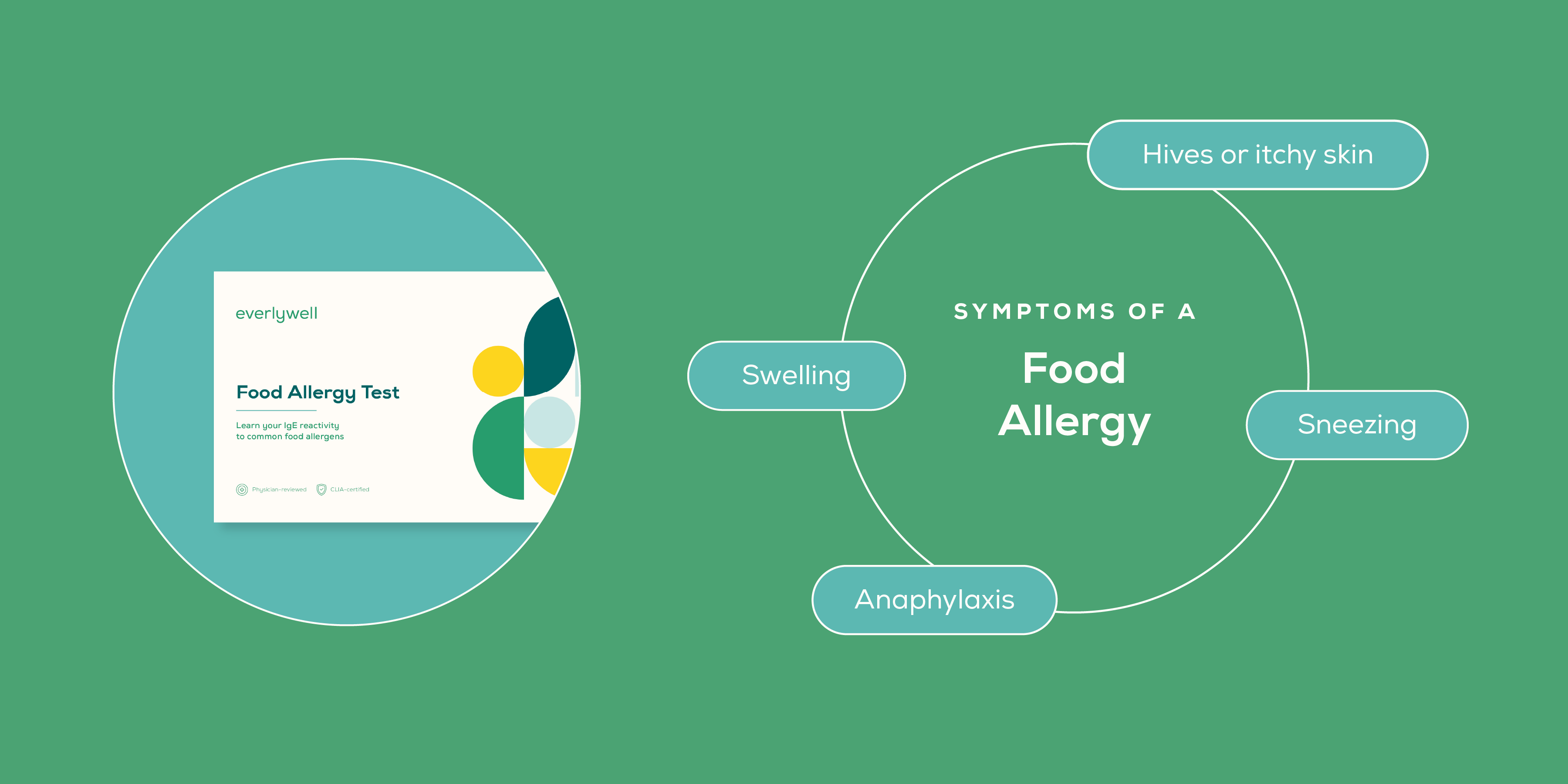
Food Allergy, Food Sensitivity, and Celiac Disease: An Expert Explains the Key Differences and How to Test
Medically reviewed on April 27, 2022 by Morgan Spicer, Medical Communications Manager. To give you technically accurate, evidence-based information, content published on the Everlywell blog is reviewed by credentialed professionals with expertise in medical and bioscience fields.
If you experience uncomfortable symptoms such as bloating, headaches, indigestion, gastrointestinal distress, or stomach pain after eating, you’re not alone. In fact, 1 out of every 4 Americans have experienced abdominal pain in the last week and over 90% of Everlywell customers say they’ve experienced a food-related symptom in the past year.
That’s why we’ve expanded our nutritional health category to include even more digestive health essentials! With our offerings of Food Sensitivity, Food Allergy, and Celiac Disease Screening Test, you can get the insights you need to help address your food-related symptoms.
In addition to launching two new digestive health tests to support your digestive health, we’re also committed to breaking down some of the misconceptions around food-related conditions.
While it’s true that food sensitivities can make you rather uncomfortable, it’s important to note that food allergies can be potentially life-threatening. That’s why it’s important to be aware of the differences between the two, and know what symptoms to look out for.
To better understand the differences between food sensitivity, food allergies, and celiac disease, we spoke to Registered Dietitian Nutritionist, Heather Hanley.
Below, Heather cuts through the confusion to break down the distinctions between symptoms between these three food issues, testing and screening options, and how to best navigate each one.
Food Sensitivity

What is it? A food sensitivity is an adverse reaction to a food. Food sensitivities can resolve after a period of abstinence and they are not life threatening.
What are the symptoms? While symptoms can vary quite a bit, some of the most common include:
- Digestive discomfort or bloating
- Gas
- Diarrhea or constipation
- Headaches
- Stomach or abdominal pain
How long does it take for symptoms to appear? Unlike the timeline of a true food allergy, symptoms from a food sensitivity can appear up to 72 hours after ingesting the trigger food.
What does diagnosis look like? A two-part elimination diet is the gold standard of testing for a food sensitivity. You can use Everlywell’s at-home collection kit to test your body’s IgG reactivity to 96 common foods and will receive results for each food rated on a scale of normal to high reactivity. From there, you’ll be guided towards the foods to priority during a two-part elimination diet, in order to help identify which foods might be causing your symptoms.
How can someone diagnosed with a Food Sensitivity best manage it? Initial treatment is to avoid the offending food. Then, an elimination diet is recommended for a period of time and the food is reintroduced into the diet as you monitor symptoms for any adverse reaction. Usually problematic foods can be re-introduced after a period of elimination with the caveat that perhaps they are consumed less frequently. In short, testing for food sensitivity with Everlywell helps expedite this process.
Food Allergy

What is it? A food allergy is an IgE immune response to a specific food that triggers a histamine reaction with potentially severe symptoms. Some of the most common foods known to cause an allergic reaction are: peanuts, tree nuts, milk, egg, fish, shellfish, wheat, and soy.
What are the symptoms? A true food allergy to a specific food can result in potentially life-threatening symptoms, like anaphylaxis, and has a nearly immediate reaction time. Symptoms can include:
- Hives or itchy skin
- Stuffy nose, sneezing, itchy, or watery eyes
- Vomiting, diarrhea, or stomach cramps
- Swelling
- In extreme cases, anaphylaxis, which can be life threatening.
How long does it take for symptoms to appear? Usually reactions are immediate, within a few minutes, although some can experience reactions a few hours later. Some people also experience a reaction referred to as Oral Allergy Syndrome [1]. This is a result of cross-reactivity, for example, if someone has a latex allergy, they can experience a reaction when they ingest avocados, kiwi or bananas. People who have pollen allergies can also experience reactions to certain fruits and vegetables.
What does diagnosis look like? There are a few different methods to help determine a food allergy:
- Skin Prick Test or Intradermal Skin Test - a positive skin prick test alone does not necessarily diagnose an allergy, nor does it indicate the severity of an allergy.
- Blood specific IgE test
- Physician supervised challenge test
- Patch test
How can someone diagnosed with a Food Allergy best manage it? The first line of defense is to avoid the offending food(s). Currently, Oral Immunotherapy and Sublingual Immunotherapy are being studied for treating food allergies. (Environmental allergies are treated with allergy shots or sublingual immunotherapy.)
It’s worth noting that many children outgrow some — if not all — of their allergies, however, it is possible for adults to develop allergies. A 2019 study in published in JAMA [2] estimates 10.8% of the US adult population have one or more food allergies.
Shop the Food Allergy Test.
Celiac Disease

What is it? Celiac disease is an autoimmune disease, also known as celiac sprue or gluten-sensitive enteropathy. Current estimates suggest that 1:100, or 1% of the population in the United States is affected and if left undiagnosed, it can damage the small intestines resulting in malabsorption of nutrients which in turn can lead to other disorders.
What are the symptoms? Some of the symptoms of celiac disease include:
- Bloating or gas
- Abdominal pain
- Diarrhea or constipation
- Nausea or vomiting
- Weight loss
In adults, symptoms may also include:
- Anemia
- Mouth ulcers
- Headaches
- Fatigue
- Joint pain
- Skin rashes/dermatitis herpetiformis (seen in approximately 10% of those diagnosed with celiac disease)
- Numbness
- Cognitive impairment
How long does it take for symptoms to appear? It can take weeks or even years to diagnose celiac disease. It’s often diagnosed in childhood, with most children with celiac disease having a close relative with the disorder [3].
What does diagnosis look like? There are a few different ways that celiac disease can be determined:
- Physical assessment of the person including symptoms listed above and manifestations of malnutrition
- Biopsy of the small intestine
- Capsule endoscopy, where a wireless camera is ingested and travels through the digestive tract recording pictures
- Serology testing includes testing for tissue transglutaminase (tTG) IgA and IgG, endomysial antibody (EMA) IgA, deamidated gliadin peptide (DZPG) IgA and IgG
- Genetic testing for HLA-DQ2 or HLA-DQ8. (All people with celiac disease have one of these gene variants found in approximately 30% of the populations. If this variant is not present, it’s unlikely that someone has celiac disease)
How can someone diagnosed with celiac disease manage it? Once diagnosed with celiac disease, it’s critical to follow a strict gluten-free diet. Even miniscule amounts from cross-contamination in food preparation can cause problems for patients with celiac disease.
Shop the Celiac Disease Screening Test.
With our expanded collection of food-related at-home lab tests, you can better understand which action plans are right for you — and get insight and guidance so you can take action on your food-related symptoms. See our entire offering of digestive health support here.
Related Links:
- What is a food allergy?
- 5 Viral TikTok food trends debunked by a Registered Dietitian
- What is the most common food allergy?
- Three professionals tell us why they love working in nutrition
References:
1. Oral allergy syndrome (OAS). American Academy of Allergy Asthma & Immunology. URL. Accessed April 13, 2022.
2. Prevalence and Severity of Food Allergies Among US Adults. JAMA. URL. Accessed April 13, 2022.
3. What is Celiac Disease? Celiac Disease Foundation. URL. Accessed April 13, 2022.
